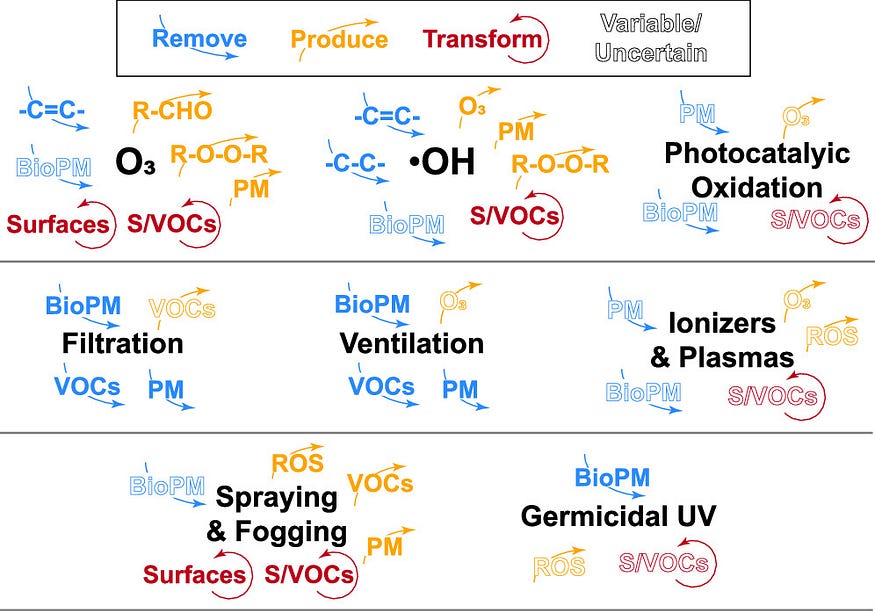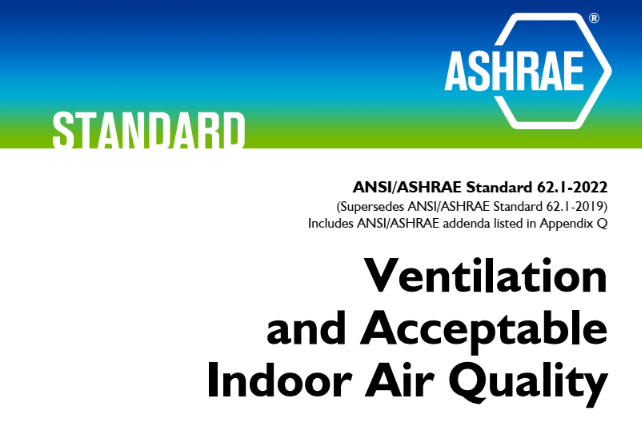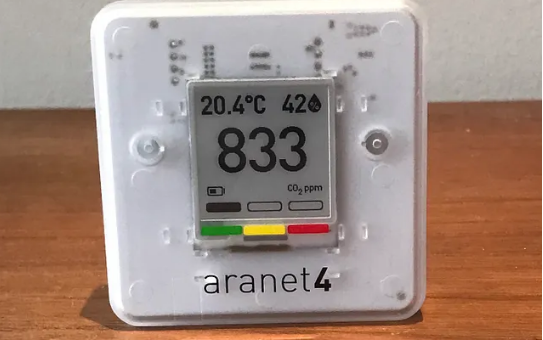Poor indoor air quality is caused by having pollutants in the air that are harmful to your well being. Good indoor air quality is simply defined as ensuring the pollutants are at acceptable concentrations. In order to ensure good indoor air quality, we need to know what the concerning pollutants are and how to keep them at acceptable concentrations. This post will discuss:
- the main indoor air pollutants
- how they can be prevented from entering the space
- how they can be removed from the space
- what applicable standards exist
- how to monitor and regulate indoor air pollutants
The Pollutants
Categories
Pollutants can be categorized based on harm. There are 4 different levels of harm:
- Fatal in the short term: carbon monoxide, lethal pathogens (e.g. legionella, tuberculosis)
- Carcinogens: radon, formaldehyde, environmental tobacco smoke
- Health threatening: allergens, volatile organic compounds (VOCs), mold, fine particulate matter, other pathogens, ozone, nitrogen dioxide
- Annoying: bad smells, body odor, VOCs
Some pollutants, such as pathogens or VOCs, can fall into multiple categories.
Most Harmful Pollutants
Despite there being many pollutants, 99% of harm comes from only 5 of them: particulate matter (PM2.5 & PM10), formaldehyde (the most harmful VOC), nitrogen dioxide, radon & ozone.

Giobertti Morantes, Benjamin Jones, Constanza Molina, and Max H. Sherman
Environmental Science & Technology. Y-axis is harm from indoor air pollutants.
The two main indoor pollutants that are addressed in building codes are formaldehyde (which also addresses other VOCs) and body odour, which is not harmful, but an annoyance. The other pollutants mostly originate from outdoors.
Source Control
The most effective solution to protect people from pollutants is preventing their entry into the space, rather than having to remove them later. Preventing the generation of pollutants is called source control. Different methods are employed depending on the origin of the pollutant.
Volatile Organic Compounds (VOCs)
Formaldehyde along with other VOCs are among the most harmful indoor generated pollutants. It is generally easy to identify them by the smell: anything that has a chemical smell is likely to have VOCs. Minnesota Department of Health has a good webpage discussing VOCs. These are the main sources:

Some advice to avoid generating VOCs indoors is to use low VOC products and avoid smoking. The smell from perfume or cologne is also caused by VOCs, so requiring spaces to be fragrance free can help avoid the health effects from them, which include throat and eye irritation, as well as annoyance. Sources of harmful VOCs like paint or gasoline should not be stored in your home or an attached garage.
Pathogens
Airborne infectious diseases such as tuberculosis, COVID-19, influenza, RSV, and the common cold, can be prevented from being emitted into the space through masking. Respirators, like N95s, are specially designed to filter the respiratory particles. Testing and isolation policies can also prevent infectious individuals from entering the space.
Legionella, which ultimately infects people through inhalation, originates from water systems. Proper water treatment can prevent legionella growth.
Mold growth is prevented by addressing any humidity or dampness issues in the space.
Combustion
Combustion can generate harmful pollutants like VOCs, nitrogen dioxide, carbon monoxide and particulate matter. Environmental tobacco smoke is the most harmful pollutant, which is why indoor smoking should be prohibited. Burning candles and incense can release particulate matter and VOCs to the space. Indoor combustion should be avoided as much as possible.
Cooking, especially when frying or using gas stoves, can generate extremely high levels of particulate matter. Avoiding the use of gas stoves and using electric or induction stoves can help, but this does not prevent issues with particulate matter generated from cooking.
Whenever there is combustion or frying foods, a range hood should be used to remove the pollutants from the space. Recirculating range hoods with a filter can reduce the levels of particulate matter, but have no effect on gases like VOCs or nitrogen dioxide. The best range hoods are ones that exhaust the air outdoors.
Particulate Matter
Particulate matter can come from the outdoors during wildfire smoke or if there is bad pollution. Limiting outdoor air entering the space and filtering any air in the space can prevent exposure to outdoor air pollution when there is poor outdoor air quality.
Indoor generated particulate matter usually comes from cooking which can be mitigated with range hoods. Other sources of dust can be prevented by cleaning the house, vacuuming often with a vacuum that has a HEPA filter and removing shoes to avoid bringing dirt into the space.
Summary
A comprehensive summary of source control of indoor air pollutants and IAQ improvements in residential spaces was created by Health Canada.

Infographic from Health Canada to Maintain Good IAQ in your home. Source
Limitations of Source Control
Many pollutants, such as body odors or carbon dioxide, cannot be prevented from being supplied to the space. Even low VOC materials will still emit some level of VOCs to the space. When significant VOC generation cannot be avoided, like applying nail polish or using cleaning products, source control cannot be solely relied upon. To address these issues, the pollutants have to be removed.
Pollutant Removal Methods
Clean Air Delivery Rate
Clean air is defined as air that is free of some pollutant. The ultimate goal of pollutant removal technologies is to reduce the concentration of pollutants to acceptable levels. The concentration of a pollutant is determined by the rate it is generated and the rate it is removed. By reducing the generation rate (source control) or increasing the removal rate, the concentration is reduced and the harm from the pollutant is mitigated. Consequently, if we know the generation rate and the harmful concentration levels, we can then determine what removal rate is required to maintain a healthy space.
Ventilation

Image by Freepik
If the problem is indoor air, often the simplest tool is to supply outdoor air to the space which is usually cleaner and then exhaust the dirtier indoor air outdoors. Ventilation is the primary tool used to improve indoor air quality as body odors, VOCs and carbon dioxide are easiest to remove through ventilation instead of any other methods. All gases that are products from combustion, are primarily removed through ventilation. Infectious respiratory aerosols which are generated indoors by people can also be removed through ventilation.
However, if the outdoor air has a high pollutant concentration, as happens during bad pollution or wildfire smoke events, ventilation can increase the indoor pollutant concentration, so it should be minimized or the air must be filtered. Ozone, which is primarily an outdoor air pollutant, increases with higher ventilation levels. Ventilation is also generally the most energy intensive method of improving indoor air quality, which means other methods should be prioritized where possible.
An introduction to ventilation, including the different types of ventilation, common problems and how it can be improved, can be found here.
Filtration

Image by macrovector on Freepik
Filtration involves passing air through a filter with a fan, which removes particles from the air and then supplies the particle-free air to the space. Filtration is the ideal method to remove particulate matter, but has no effect on gases.
A full introduction to filtration, including the different types and uses for filters, can be found here.
UV

Dr. Ashish Jha speaking at an indoor air quality conference in front of two far-UV fixtures. In the corner of the room there is an upper room UV fixture. Photo was taken by Dr. Kimberly Prather.
UV light can inactivate pathogens, making them harmless. However, it has no effect on particulate matter and many gases. It can cause chemical reactions with some types of gasses, called photooxidation. Sometimes this is marketed that UV can eliminate VOCs however, these reactions can create harmful byproducts and do not necessarily equate to high clean air delivery rates.
UV can be used in many different ways. It can be added to ducts in air handling units or placed inside portable air cleaners. Based on personal discussions with researchers in this area, due to the short contact time of the air with the UV light, these systems often require extremely high amounts of UV power and are often ineffective when installed. UV can also be used on cooling coils inside air handling units to prevent mold growth. Using UV in this way is generally ineffective against pathogens in the recirculated air.
Alternatively, UV can be used as in-room lighting systems with upper room UV or far-UV. Both of these systems have significant contact time with the air and can be extremely effective in mitigating transmission of airborne pathogens when designed and installed properly.
An introduction to the different ways of using UV can be found here.
An introduction to upper room UV can be found here.
An introduction to far-UV can be found here.
Alternative Methods

Environ. Sci. Technol. 2021, 55, 18, 12172–12179/ https://pubs.acs.org/doi/full/10.1021/acs.est.1c02582
There are many other tools that have been marketed to reduce the concentration of pathogens or other pollutants in the space. These include photocatalytic oxidation, gaseous hydrogen peroxide, ionization, bipolar ionization, hydroxyl generators and other such technologies. I am currently unaware of any evidence that these are both safe and cost effective compared to the more traditional technologies of ventilation, filtration or UV. ASHRAE 241 Normative Appendix A has provided a method to measure both the safety and effectiveness of these methods. Any device that complies with ASHRAE 241 can be considered safe and the cost and effectiveness can be evaluated compared to other technologies to determine if they should be used to improve indoor air quality.
Carbon Filters
Carbon filters, through a process called adsorption, can remove odors, VOCs, and ozone from the space. They are ineffective on fine particulate matter, which includes infectious respiratory aerosols. The biggest problem with carbon filters is that they are currently not well standardized. Filters that are too small, which is common in portable air cleaners, can saturate in a short amount of time rendering them ineffective. It is currently rare for carbon filters to be used in commercial settings. Until there is better standardization for the size, longevity and effectiveness of carbon filters, ventilation is the preferred method to remove harmful gases from the space.
Radon Removal
Radon originates from under the earth and can collect indoors. If radon is an issue, the first tool would be to prevent radon from entering your home with a plastic film in your basement. An exhaust fan can also be attached to your basement to remove it.
Summary
It can be quite complicated summarizing the different technologies and what effect they have on different pollutants. For example, this figure summarizes what we know.

Effects of air cleaning technologies on various pollutants. Source
In table form:

Air Cleaning Systems

Summary of different air cleaning systems, including central ventilation with increased outdoor air and upgraded filtration, portable air cleaners, windows and upper room UV. Image by David Elfstrom.
Using the methods of ventilation, filtration, UV or alternative air cleaning, systems can be deployed, either in individual rooms (in-room air cleaning) or outside of the room (centralized ventilation) to remove pollutants.
Centralized Ventilation
Air handling units extract air from a space, treat the air and then supply the air back to the space. Air treatment methods in air handling units can include:
- heat or cool
- humidify or dehumidify
- exhaust air and replace it with outdoor air (ventilation)
- filter the air
- expose the air to UV light
- add chemicals or ions to the air
In most systems, these units heat or cool the air, provide minimal ventilation and use low efficiency filters that are ineffective against respiratory aerosols. UV light, alternative air cleaning methods and high efficiency filtration are not standard. Increasing the amount of outdoor air, upgrading filters or adding UV are all methods that can be used to clean the air supplied to the space.
In-Room Air Cleaning
Systems can also be placed inside individual rooms to increase the clean air delivery rate to the room.
Operable windows are a way to increase the ventilation rate to the room. Windows have many disadvantages compared to mechanical ventilation, including:
- outdoor air delivery rates are not constant, but dependent on temperature, pressure differences and wind speeds.
- high outdoor air delivery rates are difficult when it is cold outside while air supplied from mechanical ventilation is tempered for comfort.
- air is not filtered which can be an issue with poor outdoor air pollution.
Portable or wall/ceiling mounted air cleaners are another option to clean the air in each space. They use a fan to bring the air into an enclosure, clean it and then supply it back to the space. Usually they include a high efficiency filter, but can also include UV or alternative air cleaning methods.
Upper room UV or far UV are lighting systems that can be added to a room to disinfect the air without requiring the use of a fan.
Standards
The engineering society which creates the standards and guidelines that are used in designs of buildings in North America is called ASHRAE. There are three relevant standards/guidelines for ensuring safe indoor air.
Acceptable Indoor Air Quality — ASHRAE Standard 62.1

In North America, the main standard for acceptable indoor air quality, which is referenced in the building codes in ASHRAE 62.1. This standard provides different methods to ensure acceptable indoor air quality, but the most commonly used method by engineers is called the ventilation rate procedure. Engineers calculate what ventilation rates are required in different spaces and design ventilation systems accordingly. The rates are designed to address body odors from people and off-gassing of VOCs from materials in the space.
Enhanced filtration is required if the outdoor particulate matter level is above the national standard. Canada has no standard, so enhanced filtration is never required.
Despite the intent of the standard to ensure that there are “no known contaminants at harmful concentrations”, the standard was not designed to mitigate transmission of airborne pathogens.
ASHRAE Standard 62.1–2022 can be found here.
Enhanced Indoor Air Quality — ASHRAE Guideline 42

ASHRAE has created guideline 42–2023 for enhancing indoor air quality beyond the requirements in ASHRAE 62.1. Some recommendations include:
- upgrading to higher efficiency MERV-13 filters (6.3.2, 10.6.2.2)
- using UV on cooling coils to prevent mold growth (6.3.2)
- 30% increase in ventilation rates (8.2.1.2)
The guideline also goes into detail about avoiding common issues with implementing aspects of 62.1.
In my opinion, an increased ventilation rate is not only justifiable for enhancing indoor air quality, but also as a safety factor. Engineers do not design for the bare minimum when it comes to heating or structural concerns. There is generally a safety factor applied above the minimum to increase the heating load and structural integrity of the building. Given that there are many possible issues that can occur with ventilation, the same standards should apply to ventilation and a safety factor of 20–30% should apply.
Control of Infectious Aerosols — ASHRAE Standard 241

ASHRAE 62.1 is required in design of new buildings, but was not meant to address infectious aerosols. This caused confusion and harm during the COVID-19 pandemic, as many places claimed they comply with ASHRAE standards, but that was compliance with 62.1 which is insufficient for mitigating transmission of airborne diseases.
ASHRAE 241 was recently developed and provides much higher rates of clean air to be delivered to the space above what is required for ASHRAE 62.1. ASHRAE 62.1 primarily requires ventilation as a mitigation tool, while 241 allows for any technology to be used, as long as it has been proven to be effective against infectious aerosols.
Posts explaining various aspects of ASHRAE 241 can be found here.
ASHRAE Standard 241–2023 can be accessed here.
Monitoring and Regulation
The current standards state that buildings need to be designed to achieve certain levels of pollutant removal, but do not require ongoing monitoring or testing. Indoor air is generally not regulated, so there are no requirements to ensure any indoor air space is safe from high concentrations of harmful pollutants, although it theoretically should be if it was designed and being run properly. Since the beginning of the COVID-19 pandemic, there have been more calls to incorporate monitoring of indoor air to ensure compliance with standards.
CO2 Monitoring

Carbon dioxide (CO2) is a generally harmless pollutant. The benefit of CO2 is that people generate it at a predictable rate. Because of this, the outdoor airflow rate per person can be directly calculated from the CO2 concentration. This can ensure compliance with existing standards or be used to assess the risk of airborne disease transmission. Use of CO2 monitors can have various limitations. Generally, spaces compliant with ASHRAE 62.1 will have CO2 levels around 1000 ppm. The CDC defines good indoor air quality at being around 800 ppm (FAQ 9).
An introduction to CO2 monitoring including how to interpret CO2 readings and what limitations there are can be found here.
Other Pollutants
It is worthwhile to monitor particulate matter, formaldehyde and radon. We currently do not have widely deployable monitors for pathogens.
CO2 can be used directly to measure the ventilation rate per person while other pollutants cannot because their generation rates are not as predictable. They are monitored because these pollutants in high concentrations can directly cause harm, while CO2 is generally harmless.
Regulation

Title page for the Model Clean Indoor Air Act
To ensure people are provided with clean indoor air, regulation is required. A clean indoor air act would need to be passed by lawmakers to require testing the air in public spaces and requiring the people responsible to take necessary actions to keep the pollutant concentrations at acceptable levels.
A detailed description of an indoor air quality act can be found here.




